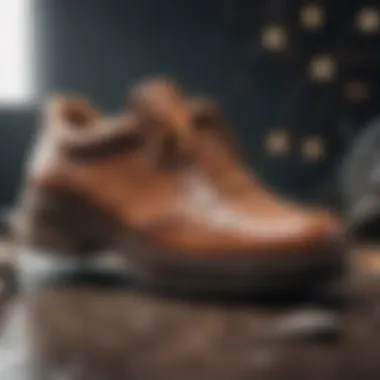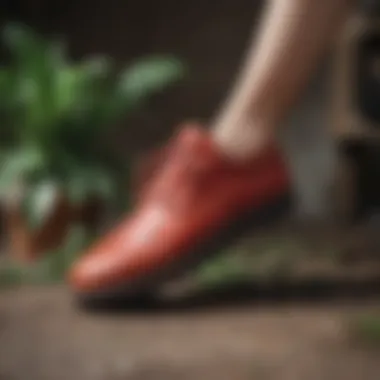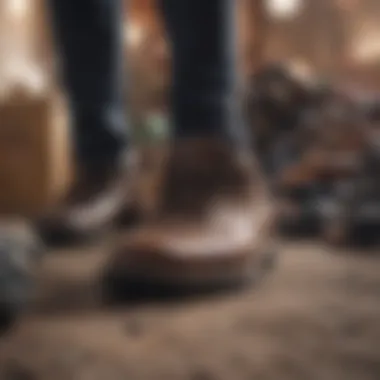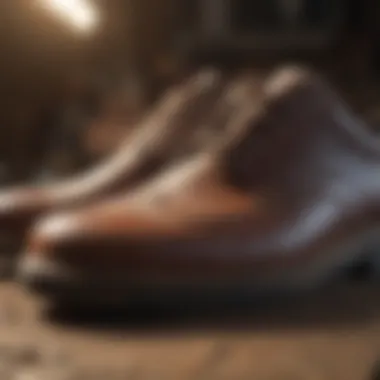Innovative Ways to Dispose of Worn-Out Shoes Sustainably


Overview of the Topic
Current Status and Challenges
The current disposal of old shoes poses a significant challenge in today's society due to the lack of awareness regarding sustainable practices. Most individuals commonly discard their old footwear in regular trash bins, leading to enormous piles of shoe waste in landfills. This inefficient method not only contributes to environmental degradation but also hinders the possibility of reusing valuable materials present in the shoes. As a result, there is a pressing need for education and advocacy on the importance of responsible shoe disposal and the detrimental effects of unsustainable practices on the ecosystem.
Sustainable Solutions
To address the issue of old shoe disposal effectively, it is crucial to explore sustainable solutions that promote resource conservation and waste reduction. Recycling old shoes through designated collection centers or charitable organizations can help divert them from landfills and channel them towards recycling facilities for material recovery. Additionally, upcycling initiatives empower individuals to transform their old shoes into new products through creativity and innovation. By encouraging community engagement in shoe recycling programs and promoting upcycling as a viable alternative, it is possible to significantly minimize the environmental impact of shoe disposal.
Impact and Importance
The impact of sustainable shoe disposal transcends individual actions, reverberating across ecosystems, communities, and future generations. By adopting environmentally friendly practices, such as recycling and upcycling, individuals can contribute to preserving natural resources, reducing carbon footprint, and mitigating pollution. Moreover, sustainable shoe disposal fosters a culture of resourcefulness and environmental stewardship, inspiring others to follow suit and collectively work towards a more sustainable future. The importance of conservation efforts in the realm of shoe disposal cannot be overstated, as it not only benefits the environment but also enriches society through the promotion of mindful consumption and waste management.
Introduction
In the realm of sustainable practices, the disposal of old shoes plays a crucial role. Our choices in parting ways with worn-out footwear can significantly impact the environment. By delving into the best methods for discarding old shoes, we pave the way towards reducing waste and promoting a more eco-conscious lifestyle. This article serves as a comprehensive guide, shedding light on the diverse approaches available to individuals looking to make a positive environmental impact.
Shoes, being a staple in our daily lives, often endure wear and tear quicker than we anticipate. When these shoes reach the end of their utility, it becomes imperative to consider the most eco-friendly way to bid them adieu. Now more than ever, environmental consciousness is on the rise, prompting us to rethink how we discard items, including our footwear. Excitingly, the world of shoe disposal is brimming with innovative solutions that balance practicality with sustainability.
Donate Your Old Shoes
In the quest for environmentally friendly shoe disposal methods, donating your old shoes emerges as a noble and sustainable solution. By choosing to donate, you not only extend the life cycle of your shoes but also contribute to meaningful causes. This section delves into the significance and benefits of donating old shoes, shedding light on crucial aspects to consider for an impactful donation process.


Local Charities and Nonprofit Organizations
Local charities and nonprofit organizations play a pivotal role in facilitating the donation process of old shoes. These entities often have dedicated programs that support underprivileged communities, disaster relief efforts, and sustainable fashion initiatives. By donating to local charities, you can directly impact individuals in need and promote a circular economy within your community. It is crucial to research and choose reputable organizations that align with your values to ensure your donation makes a positive difference.
Shoe Donation Bins
Shoe donation bins serve as convenient drop-off points for individuals looking to dispose of their old shoes responsibly. These bins are strategically placed in various locations, such as shopping centers, community centers, and educational institutions, making it easy for people to donate effortlessly. When utilizing shoe donation bins, it is important to inspect the bins' condition to ensure your shoes will reach the intended recipients intact. Additionally, consider donating shoes that are still in wearable condition to maximize their benefit to those in need.
Online Donation Platforms
In the digital age, online donation platforms have revolutionized the way people contribute to charitable causes, including shoe donations. Various websites and apps allow users to connect with charities and individuals in need, facilitating seamless donation processes. Online platforms provide flexibility and convenience, enabling donors to contribute from the comfort of their homes. When utilizing online donation platforms for shoe donations, ensure that you verify the credibility of the platform and the recipient to guarantee the ethical distribution of your donated shoes.
Recycle Your Old Shoes
Recycling old shoes is a crucial aspect within the overarching theme of sustainable waste management detailed in this comprehensive guide on disposing of old shoes. By focusing on recycling, individuals can significantly reduce the environmental impact of shoe disposal while also contributing to the conservation of resources. Recycling shoes involves the process of breaking down worn-out footwear into raw materials that can be used in the production of new items, thereby closing the loop on material usage. This systematic approach ensures that the materials from old shoes are repurposed rather than ending up in landfills, where they would contribute to environmental degradation. Moreover, recycling shoes significantly reduces the need for the extraction and processing of new raw materials, further lessening the overall environmental footprint of shoe production. Readers embarking on the journey of disposing of their old shoes through recycling can take pride in knowing that they are actively participating in a sustainable practice that benefits both the environment and future generations.
Find Local Recycling Centers
Locating nearby recycling centers is an essential step in the process of recycling old shoes. These dedicated facilities play a pivotal role in the efficient and environmentally friendly disposal of footwear by ensuring that the materials are appropriately handled and processed. By taking the time to research and identify local recycling centers that accept shoes, individuals can ensure that their discarded footwear is directed towards sustainable reuse. When exploring options for local recycling centers, it is important to consider factors such as the types of materials accepted, operational hours, and any specific guidelines for shoe recycling. Additionally, reaching out to these centers for more information on their recycling processes and how individuals can contribute effectively can enhance the overall recycling experience.
Shoe Recycling Programs
Engaging with specialized shoe recycling programs offers individuals a structured and purposeful approach to recycling old footwear. These programs are designed to streamline the recycling process, making it convenient for individuals to participate in sustainable shoe disposal. Whether organized by footwear brands, environmental organizations, or recycling initiatives, these programs provide a platform for individuals to contribute their old shoes towards environmental conservation efforts. By partnering with shoe recycling programs, participants can rest assured that their footwear will be handled in an environmentally responsible manner, ensuring that the materials are repurposed efficiently. Additionally, these programs often offer insights into the recycling journey of old shoes, showcasing the transformation of discarded footwear into valuable resources through recycling practices.
Mail-In Recycling Programs


For individuals unable to access local recycling centers or shoe recycling programs physically, mail-in recycling programs offer a convenient alternative for sustainable shoe disposal. These programs enable individuals to package and send their old shoes to designated recycling facilities via mail, allowing for remote participation in recycling initiatives. By following the instructions provided by mail-in recycling programs, individuals can ensure that their old shoes reach the appropriate recycling facilities for processing. This method of recycling is particularly beneficial for those living in areas with limited access to recycling centers or individuals seeking a hassle-free way to contribute to environmental sustainability through shoe recycling. Embracing mail-in recycling programs empowers individuals to partake in environmental conservation efforts regardless of their geographical location or constraints.
3. Upcycle Your Old Shoes
Upcycling old shoes is a crucial aspect of sustainable shoe disposal, marking a significant contribution to minimizing environmental waste. When it comes to tackling the issue of old shoe disposal, upcycling presents a creative and eco-friendly solution. By transforming worn-out shoes into new, functional items, individuals can significantly extend the lifespan of their footwear while reducing their carbon footprint. Upcycling also allows for a personalized touch, enabling individuals to inject their unique style into their creations.
DIY Shoe Projects
Engaging in do-it-yourself (DIY) shoe projects offers a hands-on approach to upcycling old shoes. From crafting new shoe designs to repurposing shoe materials for other DIY endeavors, the possibilities are endless. By embarking on DIY shoe projects, individuals can unleash their creativity and innovative skills while promoting sustainable practices. DIY shoe projects not only breathe new life into old shoes but also foster a sense of accomplishment and self-expression.
Shoe Repair and Customization
Shoe repair and customization provide an opportunity to prolong the life of old shoes by addressing wear and tear issues. By repairing damaged soles, heels, or uppers, individuals can salvage their favorite pairs of shoes and minimize their environmental impact. Customization further enhances this process by allowing individuals to tailor their shoes to their preferences, thereby increasing the sentimental and functional value of the footwear.
Repurpose Shoes for Home Decor
Repurposing old shoes for home decor serves as a unique and creative way to integrate sustainable practices into interior design. From using old shoes as planters or storage containers to incorporating them into art pieces, the options for repurposing old footwear are diverse. Repurposing shoes for home decor not only adds a touch of originality to living spaces but also promotes resourcefulness and environmental consciousness among individuals.
4. Composting Biodegradable Shoes
When it comes to the sustainable disposal of old shoes, composting biodegradable shoes emerges as a cutting-edge solution that aligns with environmentally conscious practices. This section delves into the significance of composting biodegradable shoes within the broader context of eco-friendly shoe disposal methods discussed in this article.
Composting is a natural process wherein organic materials decompose into nutrient-rich soil. Biodegradable shoes, typically made from materials like natural rubber, organic cotton, or recycled fabrics, can break down naturally in a composting environment without releasing harmful chemicals into the soil or air. This environmentally sound approach to shoe disposal not only minimizes waste but also fosters the regeneration of resources.
One key element to consider when composting biodegradable shoes is ensuring that these shoes are free from any non-biodegradable components, such as synthetic glues or plastic coatings, which can impede the composting process. Additionally, it is essential to cut the shoes into smaller pieces to expedite decomposition and create a more uniform compost mixture.


The benefits of composting biodegradable shoes are multifaceted. By diverting shoes from landfills and incinerators, this method reduces the burden on waste management systems, ultimately decreasing greenhouse gas emissions and conserving valuable landfill space. Moreover, the nutrient-rich compost produced can be used to enrich soil in gardens, contributing to sustainable agriculture practices.
In summary, composting biodegradable shoes represents a progressive approach to shoe disposal that harmonizes ecological principles with resource efficiency. By incorporating this method into your sustainability initiatives, you can play a pivotal role in promoting a greener, more circular economy while acknowledging the value of responsible consumer behavior.
5. Proper Disposal of Beyond-Repair Shoes
In the realm of sustainable shoe disposal, the proper handling of shoes that are beyond repair holds vital significance. When shoes reach a point where traditional repair or reuse is no longer feasible, it becomes imperative to consider the environmental impact of disposing of them. Understanding the various techniques and methods for managing this type of footwear waste is crucial for individuals aiming to minimize their carbon footprint and contribute to a greener future.
Search for Specialized Disposal Programs
One effective approach for disposing of shoes that are beyond repair is to search for specialized disposal programs. These programs are designed to handle footwear that may contain materials not suitable for regular disposal channels. By seeking out these programs, individuals can ensure that their old shoes are managed in an environmentally responsible manner, minimizing the harm to the ecosystem.
By collaborating with specialized disposal programs, you can rest assured that your beyond-repair shoes will be directed towards appropriate recycling or disposal facilities, preventing them from ending up in landfills where they can contribute to pollution and resource wastage. Such programs often employ advanced methods to extract valuable materials from old shoes, further promoting the circular economy and reducing the demand for new resources.
Consult Local Waste Management Guidelines
Another essential step in the proper disposal of irreparable shoes is to consult local waste management guidelines. Different regions have specific regulations regarding the disposal of different types of waste, including textiles and footwear. By familiarizing yourself with these guidelines, you can ensure compliance with legal requirements while also contributing to a sustainable waste management system.
Local waste management guidelines may provide valuable information on designated drop-off points for old shoes, directions for segregating different materials, and insights into innovative disposal techniques that are available in your area. Additionally, these guidelines may highlight opportunities for collaborating with community initiatives or recycling schemes that focus on footwear, enabling you to play an active role in environmental conservation efforts at a local level.
Conclusion
The final aspect to consider in disposing of old shoes is crucial as it ties together the entire eco-conscious process explored in this article. Conclusion becomes the pinnacle of sustainable shoe management; it encapsulates the essence of minimizing waste and maximizing utility. Through the preceding sections focusing on donation, recycling, upcycling, composting, and specialized disposal programs, the significance of not just discarding but thoughtfully parting with old footwear is evident. In a world burdened by waste accumulation, adopting responsible shoe disposal practices is not merely a trend but a necessity.
Benefits of an environmentally friendly conclusion
Embracing an eco-focused approach to shoe disposal yields multifaceted benefits. Primarily, directing worn-out shoes towards avenues that extend their lifecycle contributes directly to reducing landfill overflow. By diverting shoes from general waste, we mitigate the environmental strain caused by non-biodegradable materials. Additionally, incorporating a conscientious approach to parting with shoes promotes a culture of sustainability, urging others to follow suit in environmental stewardship. When shoes are repurposed, recycled, or donated, the collective impact fosters a greener, more responsible consumer mindset that transcends individual actions.
Considerations for bringing Conclusion to fruition
Executing a sustainable conclusion to shoe disposal mandates consideration for several elements. Firstly, understanding the local avenues available for responsible disposal is essential. Awareness of recycling centers, donation programs, and relief organizations facilitates the seamless transition of shoes from personal use to sustainable avenues. Moreover, reflecting on the broader environmental implications of footwear waste prompts individuals to make more informed choices regarding their shoe lifecycle. Navigating the diverse range of disposal options necessitates patience and diligence but ultimately leads to a more environmentally conscious lifestyle. Conclusion requires a shift in perspective from viewing shoes as mere commodities to recognizing their potential for environmental impact and positive change.



